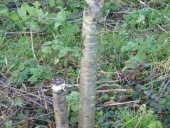




 but I thought it was interesting science which offers or could offer alternatives to plastic and/or glue.
but I thought it was interesting science which offers or could offer alternatives to plastic and/or glue.



"the qualities of these bacteria, like the heat of the sun, electricity, or the qualities of metals, are part of the storehouse of knowledge of all men. They are manifestations of the laws of nature, free to all men and reserved exclusively to none." SCOTUS, Funk Bros. Seed Co. v. Kale Inoculant Co.








rose macaskie wrote:
I painted a nasty bit of furniture with pigment and egg yoke just tried it out and there it is more than twenty years later, it has not chipped hardley or scratched and i never got round to giving it the varnish i meant to add. I am and was suprised that my crazy idea worked. I knew they used to use egg yoke to hold pigment but i thought there would be ins and outs to it and i did not know it would last so well.




 1
1








When you throw something away, there is no 'away'




"To live at all is miracle enough" ~Mervyn Peake
Baryonyx Knife Co. --Owner




 I have a question, though. Do bugs ever attack these natural paints and plasters? When I was a kid, I made a sculpture from flour-based modeling ‘clay’ and bugs ate it.
I have a question, though. Do bugs ever attack these natural paints and plasters? When I was a kid, I made a sculpture from flour-based modeling ‘clay’ and bugs ate it. 






~~~ highest use ~~~

|
They worship nothing. They say it's because nothing is worth fighting for. Like this tiny ad:
The new purple deck of permaculture playing cards
https://www.kickstarter.com/projects/paulwheaton/garden-cards
|







